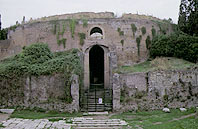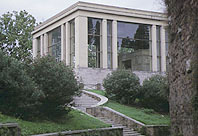Mausoleum of Augustus
 (Mausoleo di Augusto) (23 BC). The great tomb of Octavian Julio Claudia, who became Augustus Caesar, the first Emperor of Rome.
(Mausoleo di Augusto) (23 BC). The great tomb of Octavian Julio Claudia, who became Augustus Caesar, the first Emperor of Rome.
When King Mausolus in Asia Minor (southern Turkey) died in 353 BC, Queen Artemisia built him the most fantastic tomb, one of the 7 Wonders of the Ancient World.
Naturally envy, greed and all those good things made other rulers desirous of copying that great burial chamber. In so doing, the noun "Mausoleum" became part of our language, signifying a magnificent tomb. This one was the most magnificent of all.
Covering over two acres, this circular tomb was originally garnished with white marble.
The central room, where the most important urn reposed, was surrounded by a ring of niches for other family members. Like a birthday cake, this was topped with two circular drums one above the other.
A little hill - as in Etruscan tombs - was fashioned on these, and planted with thin conical cypresses. On top of this was a statue of the Emperor. There were two obelisks at the entrance (Roman copies) now at Piazza dell’Esquilino and Piazza del Quirinale.
 (13 - 9 BC). The sculpted figures on this ancient monument represent the highest quality that relief carving has ever attained.
(13 - 9 BC). The sculpted figures on this ancient monument represent the highest quality that relief carving has ever attained.
At some point in the Dark Ages this great monument disintegrated and was lost. Some of its broken friezes were buried under Rome's rubble, others scattered far and wide.
Scholars had read about the fabled Altar in ancient scrolls, but many suspected that it was only a myth. Sometimes truth is stranger than fiction, and miraculously all the pieces are finally together again after 1,500 years and safe inside a protective modern building.
Description of the relief sculptures:
1 - On the lower sections: the acanthus scrolls, intertwined with swans, are the same on all four sides.
2 - Main Entrance: these panels depict the world of legend, origins of Rome.
a) Right panel: Aeneas, with serious mien, sacrifices a fat pig on a small altar.
b) Left panel: (now destroyed) Romulus and Remus' cave, the Lupercal (Lupe= wolf).
3 - Back Entrance:
a) left: Tellus (Italy), a buxom earth goddess with two babes. Also deities of air (on a swan) and water (on a sea monster);
b) right: the godess Rome (very damaged);
4) - External side panels: these depict the great parade of 13 BC. Augustus and the Senators had something to celebrate. He had been magnificently victorious against both Spain and Gaul (France) on the fringes of the Roman world.
a) Side away from the river: though this long panel is damaged it is an absolutely faithful rendition of the Emperor with his family and followers. The Lictors lead, holding "fasces" (bundles of sticks symbolizing authority). Then comes the Emperor; though the break goes through his face and part of his body is missing, one can see enough to make out a tall, handsome young man. Next to him is the future Emperor, Tiberius, touching his arm. Then the Flamens in their head-hugging caps; they were responsible for the ceremonial fires. Following an old man carrying the sacred Imperial axe, comes Agrippa, the Emperor's best friend and son-in-law, with Augustus' wife Livia and her daughter Julia. The children are a delight of natural movement. One is tugging at his father's toga for attention. Many of the men are wearing laurel wreaths.
b) On the river side: Continuing the procession come VIPs, priests, magistrates, Senators. The High Priest, Pontifex Maximus, crowned by a laurel wreath, has his toga over his head since this is a religious ceremony. Later the emperors themselves would assume that title and function. And later still the Popes inherited the title and are therefore called "Pontiffs" (from Pontifex = Bridge Keeper)
5) - Inner Altar walls: though the ceremonial inner altar is lost, some beautiful scroll and leaf work is visible. The priests leading luckless animals to be sacrificed on the day of consecration are the finest carvings of Ancient Rome - even better than the Column of Trajan.
| Ara Pacis History 4 July 13 BC. The altar was consecrated. Built as a solemn dedication to peace, and celebrating Rome's transition from Republic to Empire. It underlines the seriousness of Rome's role as the sole superpower in a tumultuous world. It is also an amazing portrait gallery with likenesses of the most important people who participated in the actual consecration ceremony. 1525 AD. Some large Pagan marble reliefs came into the hands of Cardinal Andrea della Valle, a leading art connoisseur. The provenance of these beautiful pieces was a mystery, but thought to be from Domitian's Triumphal Arch. These ended up in the garden of Villa Medici, Rome. 1545. Cardinal Ricci of Montepulciano (see: Villa Medici) bought some other panels being excavated from Via in Lucina, Rome. These were so large he had them sawed into 3 pieces. They ended up in the Uffizi Gallery, Florence. Everybody was excited by these finds; the subject seemed to be people in a procession, all in exquisite high relief with natural drapery and expressive body movements. Other panels were scattered across Europe: the Louvre, the Vatican, Vienna. 1840s. More slabs were found while reinforcing an old palace in Rome (although the excavators didn't know, it was the same area as in 1545, Via in Lucina, at the corner of Via del Corso). 1898. The new Italian state had been formed, and they were casting about for former grandeur. Scholars mooted the idea that maybe all these different sculptural panels were from Augustus' famous, perhaps mythical, Altar of Heavenly Peace. Excavations were started under the palace at Via in Lucina - at great risk as the building was in danger of collapsing if one dug too far. After digging a little way down, they had to give up, and the last great slabs were left behind because it was too perilous to continue. 1937. Under Fascism, Mussolini at the helm, with revolutionary new technology they froze the ground to get at the marbles. And so, very gently, they dislodged the last panels, which had become part of this palace's foundations, and poured reinforced concrete instead. |
Theater of Pompey
(Teatro di Pompeo) (55 BC). Though only traces remain today, this was once the world's largest and most important stage. It was the first permanent theater built in Rome since it was made of masonry in a city where only wooden amphitheaters were legal. Pompey, anxious to add political popularity to his military successes, got around this rule by topping the balcony with a temple devoted to "Venus Vincitrix" (love conquers all). The drama between Pompey and Julius Caesar was literally acted out on this stage.
Rome invented its own form for theaters since the Greeks had built their's into the sides of hills, with no attempt to isolate the stage from the surrounding countryside. Pompey's Theater was the first in the world to have a monumental "scænæ frons", an elaborately decorated back wall of the stage that rose to the same height as the top of the auditorium so that the audience and actors were enclosed on all sides.
Accounts differ on whether it held 10,000 or 40,000 spectators; it was big.
Pompey extended it behind the stage with a giant square portico featuring sculpture gardens and taverns for the leisure-loving Romans. The complex included a convention hall with a statue of Pompey (which can be seen in Palazzo Spada). And, because Caesar was rebuilding the Senate House, or Curia, in the Forum, it was here in Pompey's Theater on the fateful Fifteenth of March (the "Ides of Mars") that Caesar met the same end as Pompey, only four years after he thought he had rid himself of all danger from his ancient rival.
Behind the Temples in the "Area Sacra" of Largo di Torre Argentina you can see traces of that temporary Curia - along side the public latrines of that era.
To get an idea of the monumentality of Pompey's Theater, walk from Largo di Torre Argentina up Via dei Giubbonari to Campo dei Fiori following the side of Pompey's ancient Portico. Once in Campo dei Fiori, look up at the buildings on your right, behind the movie theater; notice that they are curved, for they follow the rounded rear perimeter of Pompey's Theater.
The adjacent Piazza del Biscione was once the site of various entrance portals from which the audience could start to climb up to their seats in the bleachers that towered up in three circular tiers like in New York's Radio City Music Hall. Now, following Via del Biscione, slip through the passageway (closed at night) into Via di Grottapinta.
This semi-circular street with its curved building-fronts follows the edge of the former orchestra area in front of the giant stage. As in ancient times, there are many places to eat in and around Piazza del Biscione. There is even a tiny theater, Teatro Dei Satiri on Via di Grottapinta, dwarfed by the ghost of Pompey's memory.
| Theater of Pompey History 71 BC. Gnaeus Pompeius, though under-age at 35, was elected Consul for military victories in Spain and for crushing a slave insurrection led by Spartacus. 61 BC. Pompey (as he was known) was given the most magnificent "Triumph" celebration that Rome had ever seen, as conqueror of Spain, North Africa and the Near East including Palestine. He had also cleared the Mediterranean of pirates. 60 BC. Pompey formed the "First Triumvirate" with two other generals, Julius Caesar - to whose daughter Julia he was married - and Crassus. 55 BC. Pompey's Theater was dedicated as a temple. The theater was inaugurated separately with elaborate games, exhibitions of marvels and the slaughter of 500 lions and 18 elephants. During the following two years Crassus and Pompey's wife Julia died. 48 BC. Pompey, finally defeated by Caesar after four years of Civil War, is killed by his own centurion just as he was landing in Egypt in search of a safe haven. 44 BC. Caesar is killed in the portico attached to Pompey's theater, stabbed by a group of his fellow-senators, including Brutus, his adopted (and perhaps natural) son and Cassius. Like Pompey, Caesar was the victim of his own ambition; he had gotten himself appointed Perpetual Dictator and proclaimed himself a god. He was entering the temporary seat of the Senate, where he was to be proclaimed King of the Orient, when it all happened. Gasping "Tu quoque, Brute" (You too, Brutus) and putting his toga over his head, he expired in front of the grandiose statue of his rival and son-in-law Pompey. |
Piazza del Biscione (Map F6)